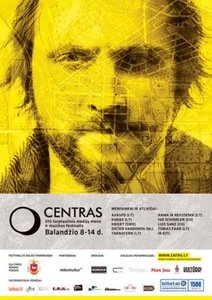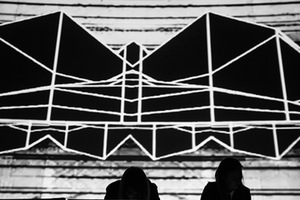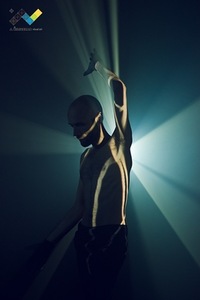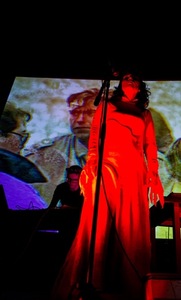8TH INTERNATIONAL FESTIVAL OF MEDIA ART AND MUSIC “CENTRE”: WHAT’S IN THE CENTRE? 0
In brief: The international media art and music festival “Centre” invited to visit several spaces in the centre of Kaunas on April 8-14. The festival is organised since 2002, and the need for the format of the festival appeared when the synthesis of different art disciplines, science and medias became an actual and separate form of cultural communication. The theme of the festival of this year became clear when the calls for artists were announced – dialects, their significance and place in the contemporary audiovisual culture was emphasised.
The festival was opened at Romuva Cinema by the exhibition of five different artists. Tadas Černiauskas (aka Tadao Cern) presented his newest work “Paintography”. The video installation of Elena Sakalauskaitė “A Message in a Bottle” appeared rather primitive by its idea and form. Video works of the designer Jurgita Juodytė (video performance “Dialect”) and the animated film of Virgis Malčius “Knob” spoke about the boring but actual themes, such as lack of understanding and the increasing emotional distance among people. The holographic sound sculpture “SnubCube” became one of the most attractive exhibits. The authors Rimas Sakalauskas and jeweller Marija Ražinskaitė strove to reveal the phenomenon of a replenished space of reality by their project. This sculpture became the only exhibit in the collective exhibition that corresponded to the specifics and concept of the festival.
On the second day lectures were read at Vytautas Magnus University gallery 101. Reports on the chosen themes were read by Dario Martinelli (“Culture and Dialect of Music Video Clips: the Case of the Beatles”), Aidis Stukas (“Social Networks: Text, Word, View”), Adrien Siberchicot (“Media and Mediation”) and Vytautas Tinteris (“Sexuality in Films”). Still, it is necessary to note that the “lecturers” lacked concentration, professionalism and responsibility to the chosen theme.
The third evening of the festival was dedicated to sound art experiments at the Attic Hall. The evening was started by Arma and Refusenik, later Lukas Petraitis performed and stood out by broken sound textures. Antanas Dombrovskis performed one of the most memorable pieces that evening – he presented himself on the stage as Gana2. Meanwhile, the programme of Daina Dieva stood out by meditative stylistics and perfect show. The evening ended with the cold show of post-industrial music project Girnų Giesmės.
On the following day the programme of live audiovisual performances was presented at Romuva Cinema. It started with the debut performance of the collective Bionics “Versus”. The group of audiovisual poetry AVaspo introduced its third album “Ocean is Bbleeding” using a similar audiovisual formula. The presentation of the album became a conceptual performance that provoked the audience to leave their comfort zone. The video artist Eglė Eigirdaitė, aka VJ Suckmafinger, granted an exceptional visual shape to the performance. As for the following show of the instrumental-experimental music band Kriget from Sweden, the specifics of a film hall was not so thankful to it. A different space and wider audience is necessary for the intensive and strong music of the band.
On the evening before the last the audience was eager to hear the recently created project Kurak of the producer Vygintas Kisevičius. Still, the project may appear boring and late for the audience, the taste of which is formed by world music rather than Lithuanian music tendencies.
On the last evening the festival moved to the former Lituanica factory, Fluxus Ministry, where audiovisual performances of Dieter Vandoren (the Netherlands) and Tobias Faar (Lithuania) were presented. Works of Dieter Vandoren balanced between art and technology. The performance “Integration.04” shown in the festival was interactive and spatial – it was the only live performance that implemented the concept of the festival fully. The following performance of Tobias Faar only reminded that involvement and the will to search for innovative forms and solutions was missing on the Lithuanian stage.
In general, it is rejoicing that the initiative of “Centre” born in Kaunas 12 years ago is still alive. The festival changes, broadens and has no analogues in Lithuania until now. Still, it is sometimes worth to shoot less but to the centre.












